一. 什么是Table API
1.1 Flink API总览
首先:flink根据使用的便捷性提供了三种API,自下而上是:
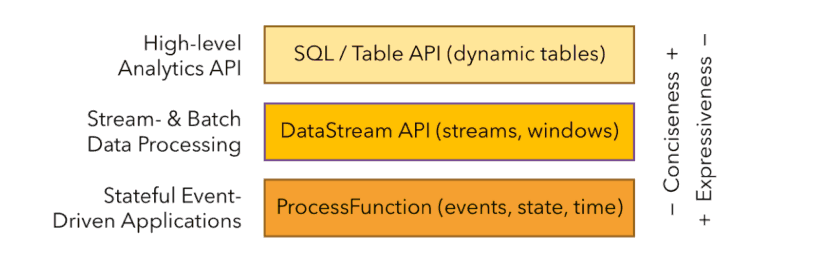
Table API & SQL
声明行:用户只关心做什么,不用关心怎么做
高性能:支持性能优化,可以获取更好的执行性能
流批统一:相同的统计逻辑,既可以流模式运行,也可以批模式运行
性能稳定:语义遵循SQL标准,不易变动
易理解:语义明确,所见即所得
Table API:tab.groupBy(“word”).select(“word,count(1) as count”)
SQL:SELECT word,COUNT(*) as cnt FROM MyTable GROUP BY word
1.2 Table API 特点
1、Table API使得多声明的数据处理起来比较容易
例如:我们把a大于10的数据存xxx的外部表,同时需要把a小于10的数据插入到外部表yyy,我们是使用TableAPI很方便。
Table.filter(a>10).insertInto(“xxx”)
Table.filter(a<10).insertInto(“yyy”)
2、TableAPI使得扩展标准SQL更容易(当且仅当需要的时候)
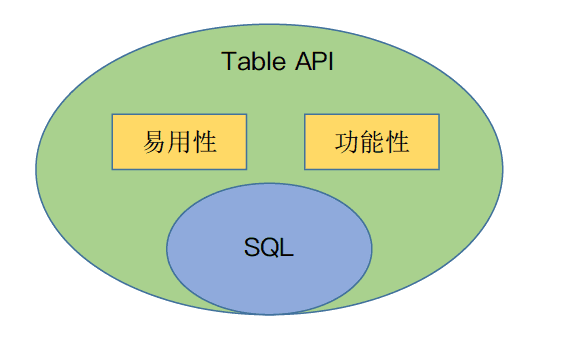
二. Table API 编程
2.1 WordCount示例
1
2
3
4
5
6
7
8
9
10
11
12
13
14
15
16
17
18
19
20
21
22
23
24
25
26
27
28
29
30
31
| import org.apache.flink.api.common.typeinfo.Types;
import org.apache.flink.streaming.api.environment.StreamExecutionEnvironment;
import org.apache.flink.table.api.Table;
import org.apache.flink.table.api.TableEnvironment;
import org.apache.flink.table.api.java.StreamTableEnvironment;
import org.apache.flink.table.descriptors.FileSystem;
import org.apache.flink.table.descriptors.OldCsv;
import org.apache.flink.table.descriptors.Schema;
import org.apache.flink.types.Row;
public class JavaStreamWordCount {
public static void main(String[] args) throws Exception {
StreamExecutionEnvironment env = StreamExecutionEnvironment.getExecutionEnvironment();
StreamTableEnvironment tEnv = TableEnvironment.getTableEnvironment(env);
String path = JavaStreamWordCount.class.getClassLoader().getResource("words.txt").getPath();
tEnv.connect(new FileSystem().path(path))
.withFormat(new OldCsv().field("word", Types.STRING).lineDelimiter("\n"))
.withSchema(new Schema().field("word", Types.STRING))
.inAppendMode()
.registerTableSource("fileSource");
Table result = tEnv.scan("fileSource")
.groupBy("word")
.select("word, count(1) as count");
tEnv.toRetractStream(result, Row.class).print();
env.execute();
}
}
|
1
2
3
4
5
6
7
8
9
10
11
12
13
14
15
16
17
18
19
20
21
22
23
24
25
26
27
28
29
30
31
| import org.apache.flink.api.common.typeinfo.Types;
import org.apache.flink.streaming.api.environment.StreamExecutionEnvironment;
import org.apache.flink.table.api.Table;
import org.apache.flink.table.api.TableEnvironment;
import org.apache.flink.table.api.java.StreamTableEnvironment;
import org.apache.flink.table.descriptors.FileSystem;
import org.apache.flink.table.descriptors.OldCsv;
import org.apache.flink.table.descriptors.Schema;
import org.apache.flink.types.Row;
public class JavaStreamWordCount {
public static void main(String[] args) throws Exception {
StreamExecutionEnvironment env = StreamExecutionEnvironment.getExecutionEnvironment();
StreamTableEnvironment tEnv = TableEnvironment.getTableEnvironment(env);
String path = JavaStreamWordCount.class.getClassLoader().getResource("words.txt").getPath();
tEnv.connect(new FileSystem().path(path))
.withFormat(new OldCsv().field("word", Types.STRING).lineDelimiter("\n"))
.withSchema(new Schema().field("word", Types.STRING))
.inAppendMode()
.registerTableSource("fileSource");
Table result = tEnv.scan("fileSource")
.groupBy("word")
.select("word, count(1) as count");
tEnv.toRetractStream(result, Row.class).print();
env.execute();
}
}
|
1
2
3
4
5
6
7
8
9
10
11
12
13
14
15
16
17
18
19
20
21
22
23
24
25
26
27
28
| import org.apache.flink.api.common.typeinfo.Types;
import org.apache.flink.api.java.ExecutionEnvironment;
import org.apache.flink.table.api.Table;
import org.apache.flink.table.api.java.BatchTableEnvironment;
import org.apache.flink.table.descriptors.FileSystem;
import org.apache.flink.table.descriptors.OldCsv;
import org.apache.flink.table.descriptors.Schema;
import org.apache.flink.types.Row;
public class JavaBatchWordCount {
public static void main(String[] args) throws Exception {
ExecutionEnvironment env = ExecutionEnvironment.getExecutionEnvironment();
BatchTableEnvironment tEnv = BatchTableEnvironment.create(env);
String path = JavaBatchWordCount.class.getClassLoader().getResource("words.txt").getPath();
tEnv.connect(new FileSystem().path(path))
.withFormat(new OldCsv().field("word", Types.STRING).lineDelimiter("\n"))
.withSchema(new Schema().field("word", Types.STRING))
.registerTableSource("fileSource");
Table result = tEnv.scan("fileSource")
.groupBy("word")
.select("word, count(1) as count");
tEnv.toDataSet(result, Row.class).print();
}
}
|
参考:https://github.com/hequn8128/TableApiDemo
Environment
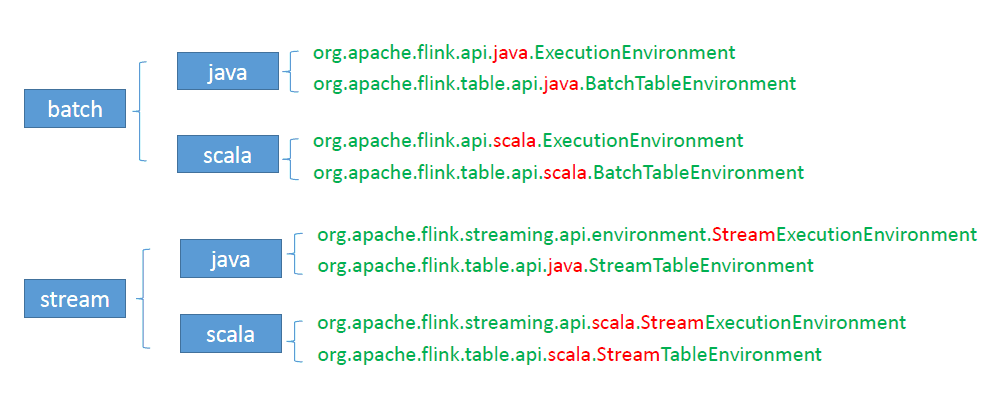
Table Environment使用优化
https://mail.google.com/mail/u/0/?tab=wm#search/label%3Aflink-dev+table+environment/FMfcgxvzMBlhTWVjxlzCnVZsLvvDkmph
https://cwiki.apache.org/confluence/display/FLINK/FLIP-32%3A+Restructure+flink-table+for+future+contributions
2.2 TableAPI操作
(1)how to get a Table
Table myTable = tableExnvironment.scan(“MyTable”); //Table 是从tableExnvironment中scan出来的,那么MyTable是如果注册呢,即:How to register a table?大致又三种:
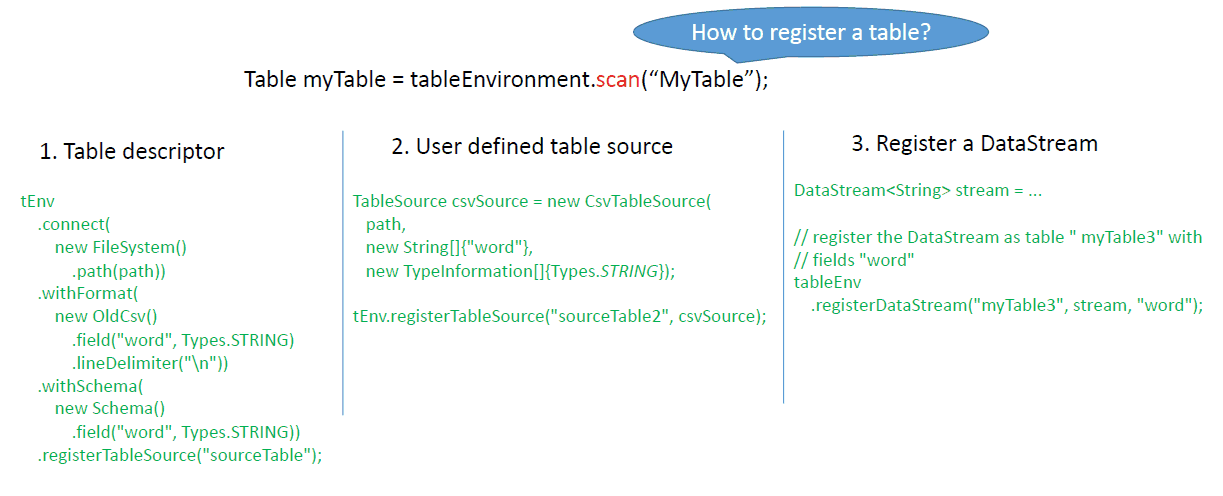
(2)how to emit a Table
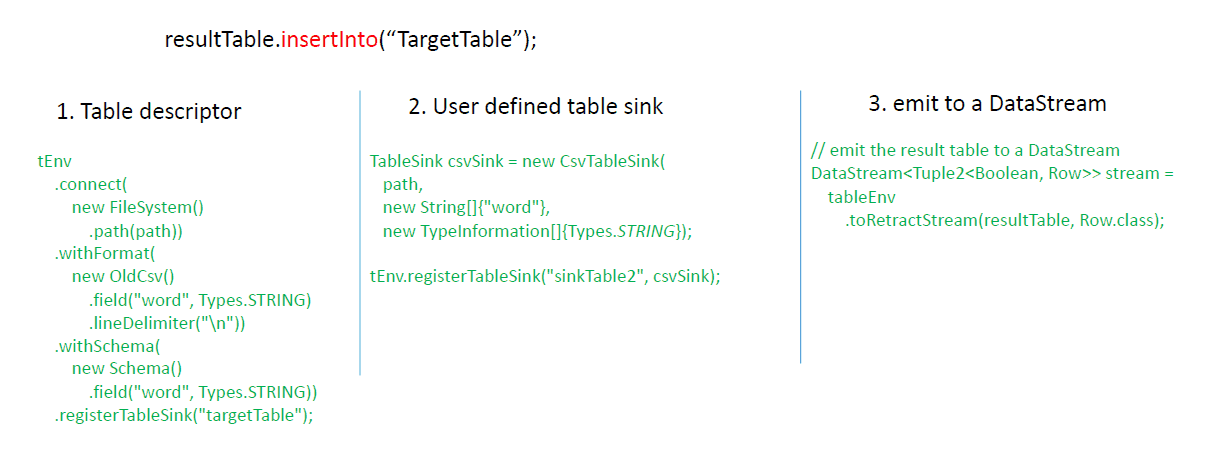
(3)how to query a Table
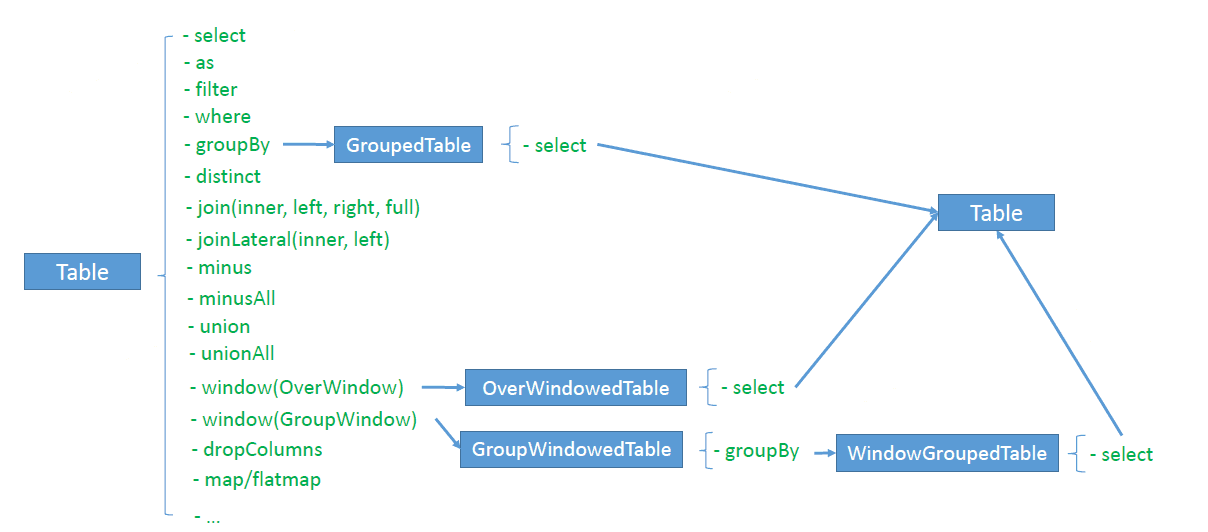
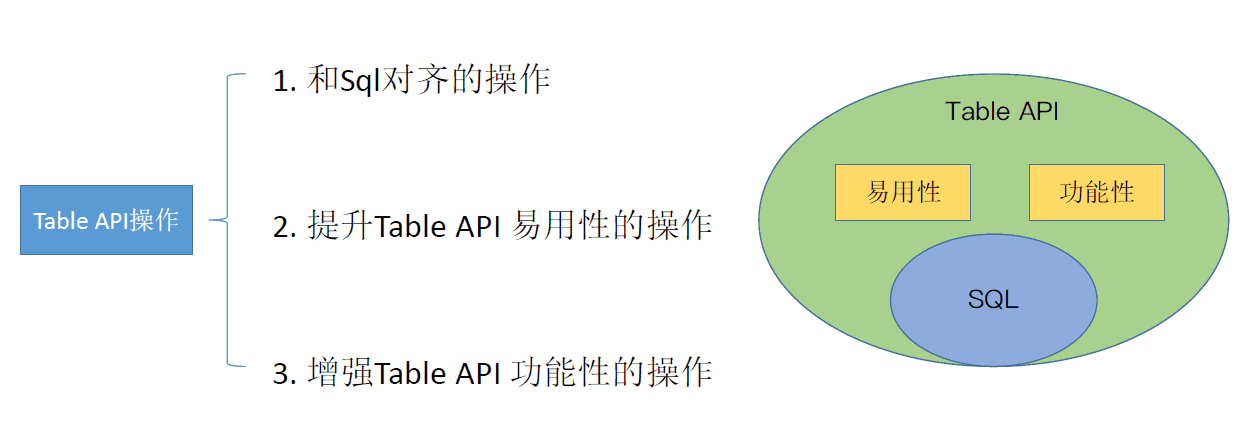
Columns Operation & Function
Columns Operation - 易用性
假设有一张100列的表,我们需要去掉一列,需要怎么操作?
| Operators |
Examples |
| AddColumns |
Table orders = tableEnv**.scan(“Orders”);** Table result = orders**.addColumns(“concat(c, ‘sunny‘)as desc”);** |
| AddOrReplaceColumns |
Table orders = tableEnv**.scan(“Orders”);** Table result = orders**.addOrReplaceColumns(“concat(c, ‘sunny’) as desc”);** |
| DropColumns |
Table orders = tableEnv**.scan(“Orders”);** Table result = orders**.dropColumns(“b, c”);** |
| RenameColumns |
Table orders = tableEnv**.scan(“Orders”);** Table result = orders**.renameColumns(“b as b2, c as c2”);** |
假设有一张100列的表,我们需要选择第20-第80列,需要怎么操作?
Columns Function - 易用性
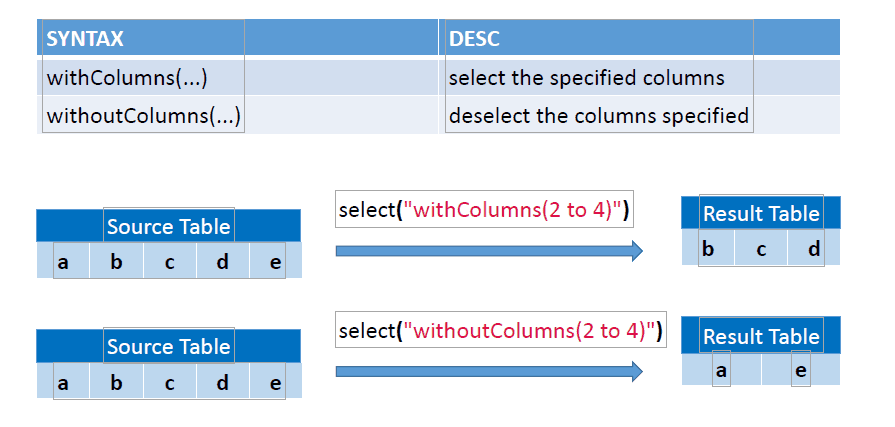
Syntax
The proposed colu mn operati on syn tax is as follows:
columnOperation:
withColu mn s(colu mn Exprs) / withoutColu mn s(colu mn Exprs)
columnExprs:
columnExpr [, columnExpr]*
columnExpr:
columnRef | columnlndex to columnlndex | columnName to columnName
columnRef:
colu mnN ame(The field n ame that exists in the table) | colu mnln dex(a
positive in teger start ing at 1)
Example: withColumns(a, b, 2 to 10, w to z)
总结
| API |
Example |
| Columns Operation |
table.dropColumns(‘a, ‘b) |
| Columns Function |
table.select(withColum ns(‘a, 1 to 10)) |
Row-based Operation
** Map operation - 易用性**
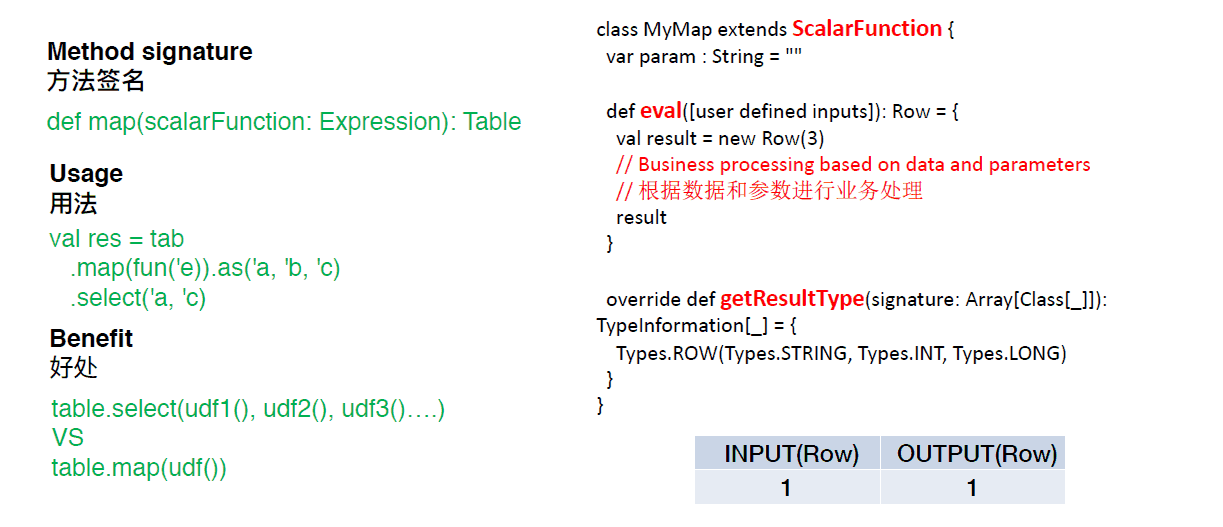
FlatMap operation - 易用性
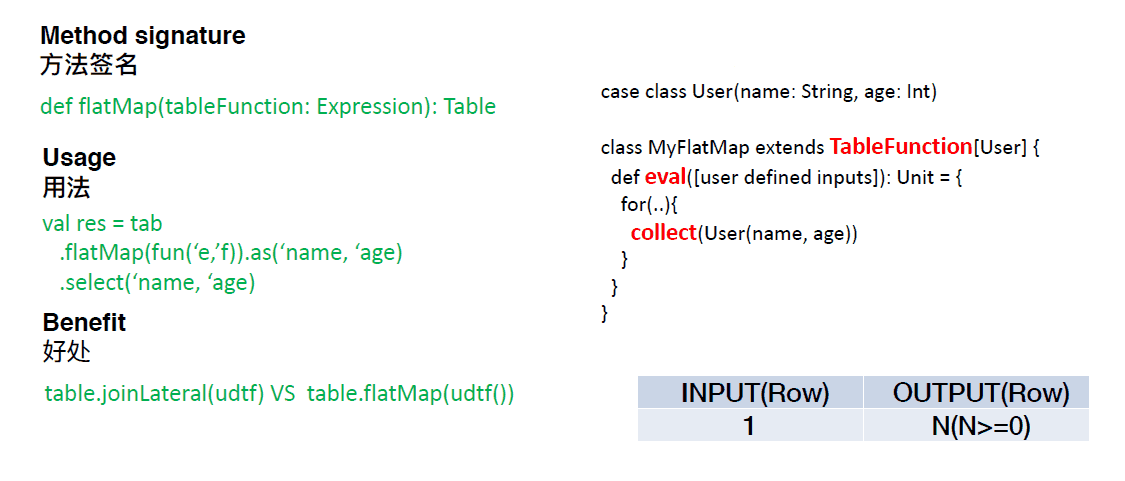
Aggregate operation 一 易用性
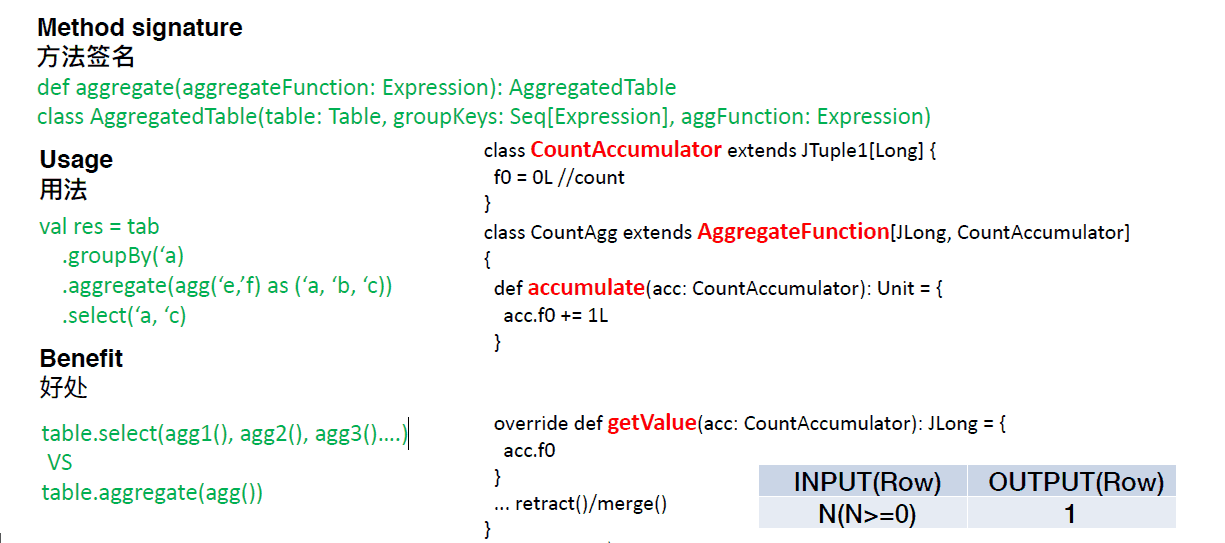
FlatAggregate operation —功能性
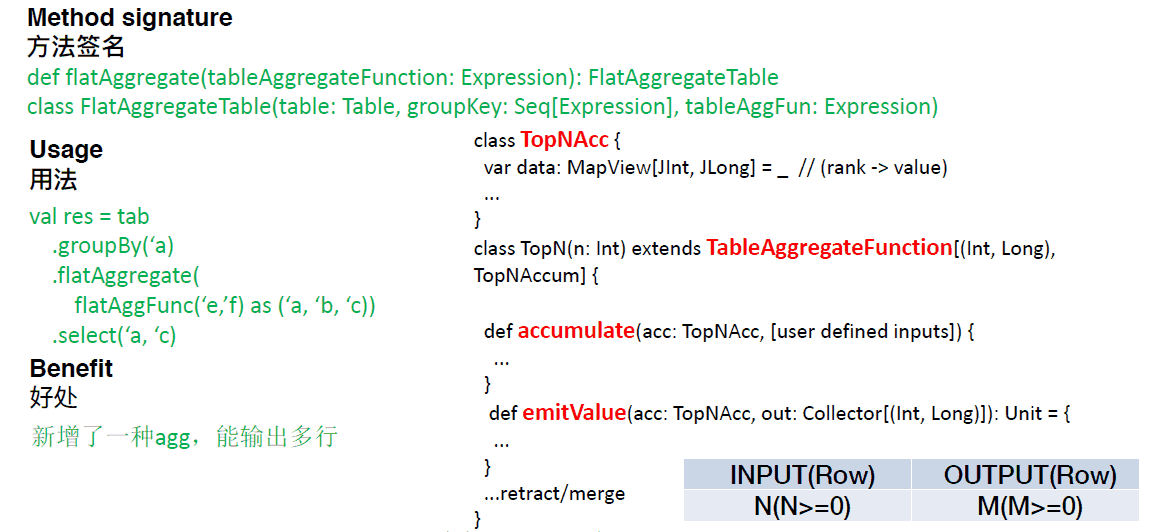
Aggregate VS TableAggregate
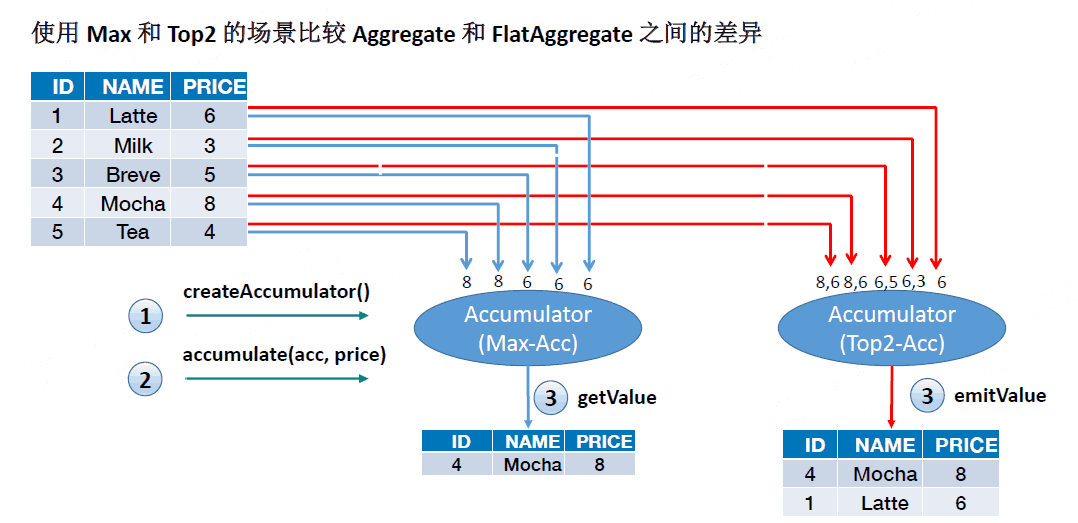
总结
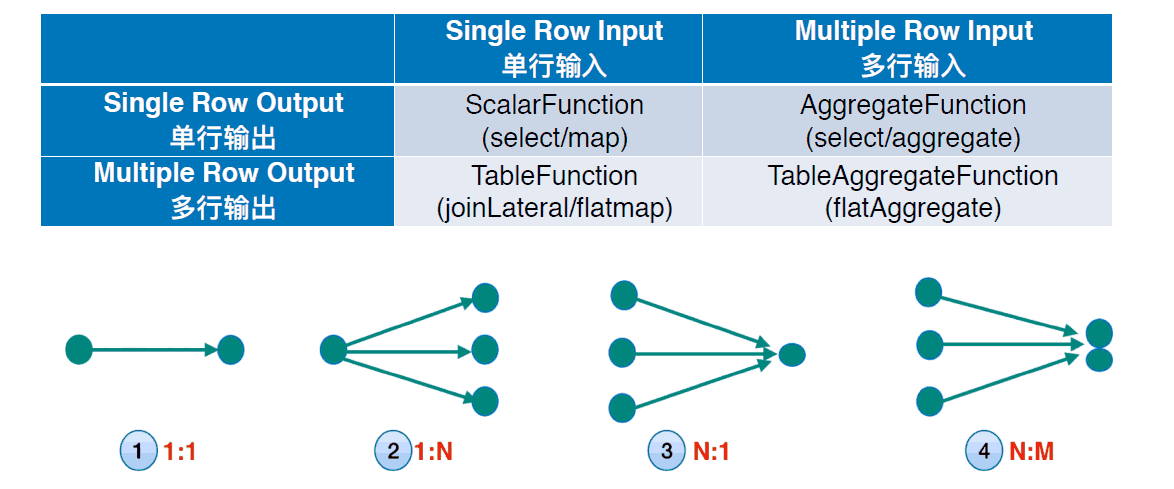
三. Table API 动态
3.1 Flip29
https://issues.apache.org/jira/browse/FLINK-10972
3.2 Python Table API
https://issues.apache.org/jira/browse/FLINK-12308
3.3 Interactive Programming(交互式编程)
https://issues.apache.org/jira/browse/FLINK-11199
3.4 Iterative processing(迭代计算)
https://issues.apache.org/jira/browse/FLINK-11199













